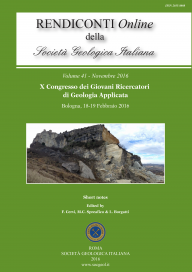
Definition and mapping of potential rockfall source and propagation areas at a regional scale in Basilicata region (Southern Italy)
Lucia Losasso (a), Marc-Henri Derron (b), Pascal Horton (b), Michel Jaboyedoff (b), & Francesco Sdao (a)
(a) School of Engineering, University of Basilicata, Viale dell'Ateneo Lucano 10, 85100 , Potenza, Italy. E-mail: lucia.losasso@unibas.it (b) Institute of Earth Sciences (ISTE), Faculty of Geosciences and Environment, University of Lausanne, 1015 Lausanne, Switzerland
Volume: 41/2016
Pages: 175-178
Abstract
An overview of the more interesting results of the rockfall source areas and propagation obtained in different zones (Province of Potenza) of Basilicata Region is presented and discussed. Basilicata Region is considered one of the regions in the Mediterranean basin most subject to slope instability. In particular, rockfalls constitute a major hazard in numerous rock cuts in such mountainous area, giving rise to casualties, damages and injuries. For mapping of rockfalls susceptibility, it has been possible to calculate the source areas and the propagation. Slope Angle Distribution procedure (SAD) has been adopted to assess the potential rockfall source areas: it allows to show the characteristic of morphological units, such as rock cliffs, steep slopes, footslopes and plains. Potential rockfall source areas are identified by a threshold angle (above the morphological unit "steep slopes"). Then rockfalls spreading area is assessed using GIS and process-based software: Flow-R (Flow assessment at a Regional Scale). The limit of the applied method is due to the unavailability of high resolution DEM of the study area, nevertheless potential rockfall source areas are identified through the slope angle distribution deduced from geological and topographic maps GIS format.
Keywords
Get Full Text